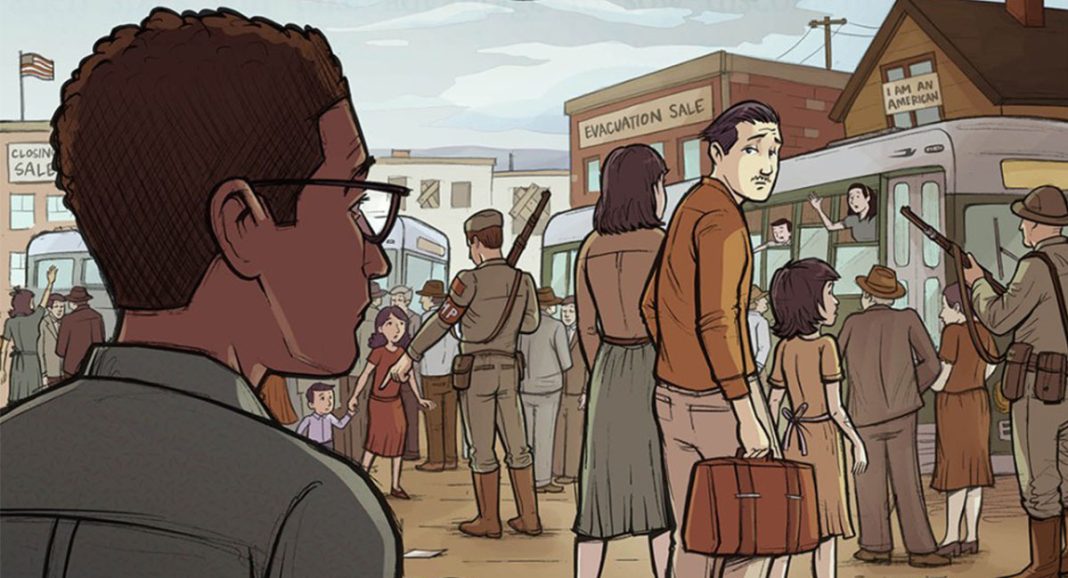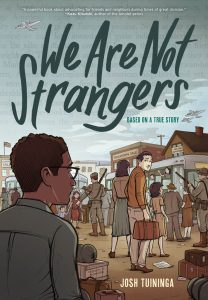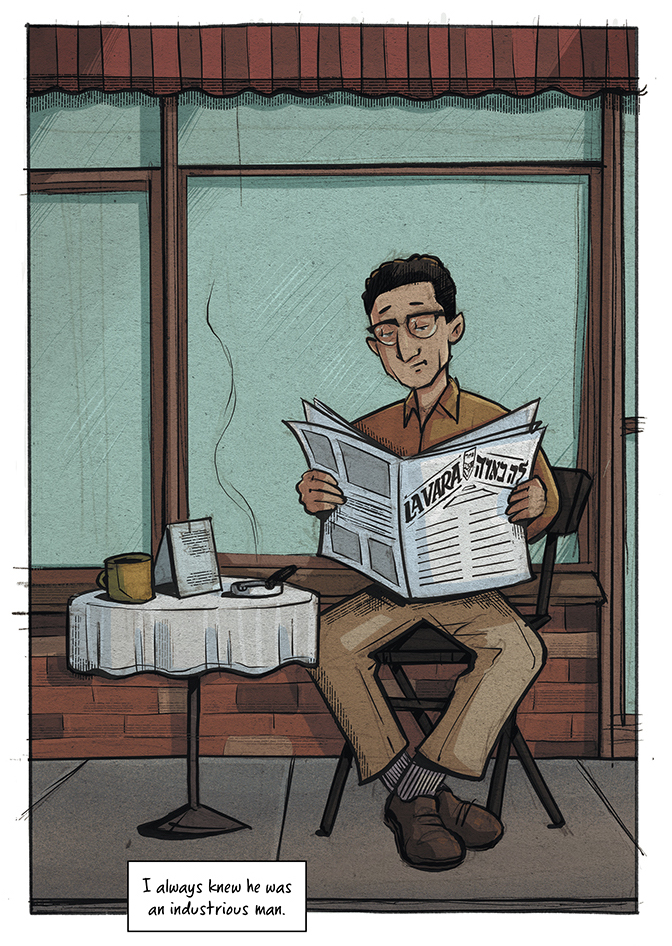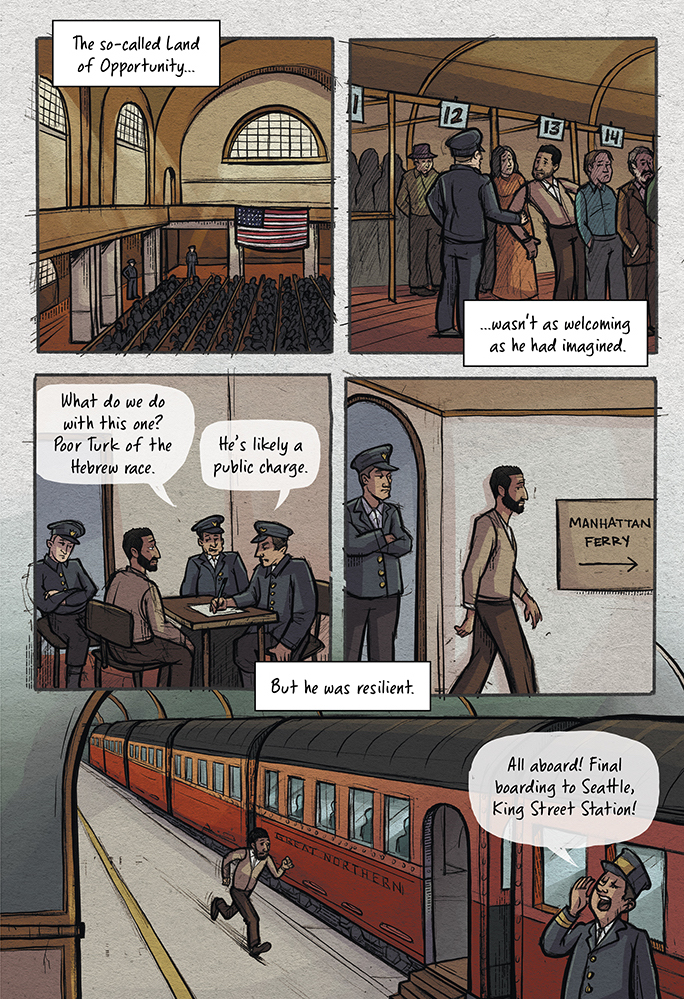We Are Not Strangers
Writer/Artist: Josh Tuininga
Publisher: Abrams
Publication Date: September 12, 2023
It’s often by being specific that a story can take on the most universal qualities. In We Are Not Strangers, out now from Abrams, creator Josh Tuininga grounds his family story and first graphic novel in ultra-specific references. Expect to learn more about Sephardic Judaism, Japanese-American life, and the immigrant experience in Seattle’s Central District in the 1940s. At its core, it’s a relatable tale of friendship, shared experiences of discrimination, and the power of individuals to make a difference.
Stories about Japanese-American internment during World War II are arguably having a moment in graphic novels. I would be remiss not to mention George Takei’s They Called Us Enemy (2019) with Justin Eisinger, Stephen Scott, and Harmony Becker, Displacement by Kiku Hughes (2019), We Hereby Refuse by Frank Abe, Tamiko Nakamura, Ross Ishikawa and Matt Sasaki (2021), My Nest of Silence by Matt Faulkner (2022) and Those Who Helped Us by Ken Mochizuki and Hughes (2022). The widespread popularity of Takei’s book might have opened the door a little wider for creators. And we are richer for it: it’s an excellent medium to convey this important history.
It’s fascinating to see another take on this period in We Are Not Strangers. This isn’t a tale that zooms in on camp life specifically. Instead, it’s a throughline of a friendship between a Jewish family, the Calvos, and a Japanese-American family, the Akiyamas, and one man’s meticulous work to hold onto his Japanese-American friends’ property until they return.
A historian’s approach
Tuininga does include a short and moving overview of some key points about the incarceration camps and their aftermath. I learned more statistics and context than I was previously aware of, enough to make my blood boil.
Tuininga approaches the book as a historian, with citations, footnotes, and deeply researched visual and text details. Posters, news headlines, and Seattle landmarks are pulled directly from life. Small moments of daily life, both connection and loss, come vividly to the fore. Tuininga’s art is mildly stylized, with muted, textured colors. His dialogue and narration strike a good balance between showing and telling. The experience is naturalistic, a reminder that terrible things can be mundane, and so can courageous ones.
The grandson in the story, who shares the story of his grandfather Marco Calvo’s life, is not meant to be a stand-in for creator Tuininga. Instead, it seems, the grandson is based on Tuininga’s uncle, who was also named Marco. It was his grandfather who helped Japanese-Americans during the war. If I’m understanding the relationships correctly, this is primarily a story about Marco Calvo (senior), Tuininga’s great-grandfather.
My favorite aspect of the book is the patient, consistent way that the elder Marco approaches helping his friends. It’s a reminder that any of us, through steady action, can stand up for our neighbors.
Personal connections
I’m not merely a bystander in this period. My mother’s family were incarcerated too. And my father’s side is Jewish. So I can understand some of the simpatico between Jews and Japanese-Americans, sharing outsider identities in the U.S.
Also, implausibly, as this book came out I was in the midst of learning more about a white family that helped my mother’s maternal family during incarceration. They mailed incredible numbers of supplies, helped manage paperwork, drafted recommendations, and wrote over 100 letters to my family in their camp. Organizations like the Japanese American National Museum (JANM) have preserved many records and letters from this period.
Given the often brutal conditions of camp (extreme heat, extreme cold, illnesses, malnutrition), it’s probably not hyperbole to say that I may owe my good health and even my life to the efforts of these amazing friends. And I didn’t even know until now. Preserving the future well-being of Japanese-American friends in camp like property and finances, as Marco did, is another immense effort to be lauded. So many families lost everything and had to start over, struggling for years.
In the story, the younger Marco’s discovery of his grandfather’s aid to Japanese-Americans after his grandfather’s death parallels my own journey. This book’s portrayal of another individual who worked so hard to help Japanese-Americans hits home for me, big time. I’m so glad Tuininga is telling his family’s story.
Implications and impact
The friends of Japanese-Americans and residents of Japanese descent during the war were priceless beyond measure. There is an important message here, of the lifelong impact of people who took action even if their own family wasn’t threatened, sometimes at great risk to themselves.
These people were an inspiring part of U.S. history, my own and Tuininga’s. I’m deeply indebted to them. Whether or not you have a personal connection to this history, I think you’ll find this story a hopeful, informative, and enjoyable read about a dark time.
We Are Not Strangers is out now in both print and digital from Abrams.
Check The Beat’s review section for a new graphic novel review every Friday in 2023!





![The main character, a man named Marco Calvo, deposits a check through a bank window and then walks away. He later sits, smoking and reading a newspaper that reads: Nazis Smash, Loot, and Burn Jewish Stores & Temples; Thousands of Jews Arrested. Narration: ... to send for those he'd left behind. [Narration continued from another page]](https://www.comicsbeat.com/wp-content/uploads/2023/09/We-Are-Not-Strangers-page-24.jpg)

![Marco Calvo walks in the Seattle Central District. Narration: He discovered a separate part of town. A sequence of panels shows a synagogue, Marco shaving, and his wedding photo. Narration: Where he could start to build a community, a synagogue, and a family. Marco sits at his desk writing. Narration: He tried his hand at business. [From We Are Not Strangers, about how a Jewish man helps a Japanese-American family during World War II.]](https://www.comicsbeat.com/wp-content/uploads/2023/09/We-Are-Not-Strangers-page-22.jpg)






